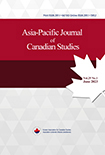The Filipina Connection: the Face of Exploitation in Canada’s Live-in Caregiver Program
The Filipina Connection: the Face of Exploitation in Canada’s Live-in Caregiver Program
- 한국캐나다학회
- Asia-Pacific Journal of Canadian Studies (APJCS)
- Vol.17 No.1
-
2011.061 - 46 (46 pages)
- 0

In this paper we explore why the primary pool of employees in Canada’s Live-in Caregiver Program (LCP) are temporary migrant workers, particularly Filipinas, as well as how the Canadian government and its related institutions justify discrepancies in the rights and protections between Canadian workers and those who come legally under Canada’s various migrant worker schemes. In this context specific attention is paid to live-in caregivers or those women who come under the domestic worker scheme. The analysis of the Canadian Live-in Caregiver Program will highlight the dominant ideologies underlying and motivating the federal government’s justification for: (a) the continuation of the program despite great external resistance; (b) the subordinate status of live-in caregivers that derives from their position as “non-citizens;” (c) the subordinate position domestic workers experience as working class women of colour; and (d) the reasoning behind a reliance on female temporary migrant workers of a specific demographic to care for Canadian dependents. To frame the entire discussion we ask (rhetorically) how it is possible for a country such as Canada that prides itself on its positive human rights and worker rights reputation, to defend a program such as the LCP that goes against the much-celebrated image of ‘Canada the good.’
Abstract
Ⅰ. Introduction
Ⅱ. The Live-in Caregiver Program (LCP): the historical backdrop
Ⅲ. Framing exploitation theoretically
Ⅳ. John Porter: Canada’s Vertical Mosaic
Ⅴ. Karl Marx: Labour Power and the Reserve Army
Ⅵ. Max Weber: The ‘Whip of Hunger’
Ⅶ. The Formal Devaluation of Live-in Caregivers
Ⅷ. Canada’s Exceptions
Ⅸ. Vulnerability and Exploitation
Ⅹ. Work Permit based on Sexist, Racist and Classist Categorization
XI. Non-Citizens
XII. Recent Revisions to the LCP: Governmental Response to Critique
XIII. The Mobilization of Migrant Domestic Workers
XIV. Conclusion
References
(0)
(0)